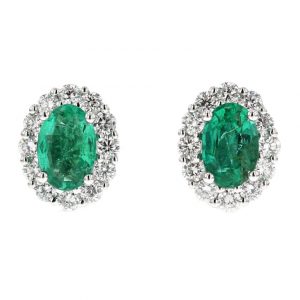Caring for Emerald Jewelry
How To Best Care For Emeralds

To insure the lasting beauty of your grandmother’s emerald, you will need to know how to care for it. A few basic tips can help you maintain the beauty and luster of the stone so that your son or daughter will also be thrilled when, with love, it is passed onto them.
Emeralds are very durable . They have a hardness of 7.5 to 8 on the Mohs scale, which means they resist scratching. They are not as hard as diamonds, rubies, and sapphires, however. These other precious gemstones can scratch your emerald so you will want to keep them stored separately in your jewelry box.

Emeralds are also not as tough as they are hard. Emeralds can be brittle, especially if they are heavily included. Although it is not common, emeralds can also experience imperfect cleavage , a characteristic that has been recognized since antiquity. It is imperative that you shield your emeralds from sudden shocks, including thermal shock, or physical impacts.
Experts estimate that up to 90% of all emeralds on the market are enhanced with either oil or resin. This makes it risky to clean emerald jewelry in the ultrasonic or steam cleaners frequently found in jewelry stores. The solutions used in ultrasonic cleaners may cause the oil or epoxy in filled fractures to dissolve, and vibrations may weaken heavily fractured stones. Warm vapor in steam cleaners may cause oil and resin to sweat out of fractures in a stone.
How To Treat Your Emerald Jewelry

The best way to clean emerald jewelry is with warm soapy water or a warm soapy cloth. Do not soak emeralds in soapy water and avoid harsh detergents that might dilute or remove oils from the stone. Never soak emeralds in solvents such as alcohol, acetone, or paint thinner.
Do not expose your emeralds to hot lights, excessive solar radiation, or other sources of heat as they may dry out fracture fillings. It is best to remove emeralds from their setting before making jewelry repairs involving heat since some fillers can be damaged. The heat of jeweler’s torches, for example, may burn resins used for fracture filling or cause oils to sweat out of surface reaching fractures. You may have to pay slightly more to repair emerald jewelry than you would for jewels with more resilient gemstones.

It is important to check your jewelry, including your emerald jewelry periodically to make sure that gemstones are secure in their mount. Losing any gemstone is a heartbreaking experience, but losing an emerald is considered bad luck. According to Fernie (1907):
“The falling of an emerald from its setting has been held an ill omen to the wearer, even in modern times.”
During the coronation of George III of England, a large emerald fell from his diadem–a harbinger, to some, of the loss of the American colonies during his reign. To prevent loss, have your jeweler tighten the settings of any gemstones that are loose.

Use a little common sense when caring for your emerald jewelry:
- Store your jewelry in separate envelopes or pouches.
- Check your jewelry often to make sure the stones are not loose.
- Avoid wearing jewelry when you are doing housework, gardening, or participating in a sport.
- Use appropriate cleaning methods.
- Do not subject your jewelry to sudden extreme temperature changes.
Your grandmother’s emerald is a valuable keepsake that requires only a little care to maintain. She wanted you to enjoy it, so by all means WEAR IT!
As we have covered many angles concerning emeralds and emerald jewelry, there are still some concepts that would be helpful for the consumer to know. We cover those next with Gemstone & Jewelry Terminology.
